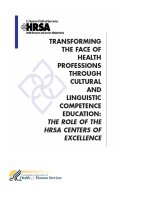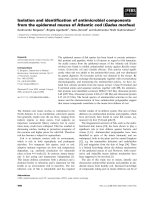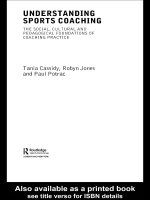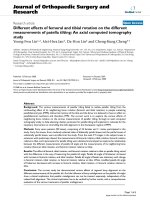Cultural and pathogenic variability of the different isolates of rhizoctonia solani causing root rot of cotton collected from Rajasthan
Bạn đang xem bản rút gọn của tài liệu. Xem và tải ngay bản đầy đủ của tài liệu tại đây (493.3 KB, 10 trang )
Int.J.Curr.Microbiol.App.Sci (2020) 9(2): 2829-2838
International Journal of Current Microbiology and Applied Sciences
ISSN: 2319-7706 Volume 9 Number 2 (2020)
Journal homepage:
Original Research Article
/>
Cultural and Pathogenic Variability of the Different Isolates of
Rhizoctonia solani Causing Root Rot of Cotton Collected from Rajasthan
Ramniwas Yadav1*, Kalpana Yadav3, Sushila Choudhary1,
Shankar Lal Yadav4 and R. N. Bunker2
1
2
Department of Plant Pathology, RARI, Durgapura, Jaipur, India
Department of Plant Pathology, Rajasthan College of Agriculture, MPUAT,
Udaipur – 313001, India
3
Department of Plant Pathology, Rajasthan College of Agriculture, India
4
Department of Plant Pathology, SKNAU, Jobner (Jaipur), India
*Corresponding author
ABSTRACT
Keywords
Rhizoctonia solani,
Sclerotia,
Morphology,
Pathogenic
variability, Cultural
characters, etc.
Article Info
Accepted:
20 January 2020
Available Online:
10 February 2020
The present study was undertaken on integrated management of root rot of cotton caused
by Rhizoctonia solani to know the disease incidence; survey was carried out during 2017
in 18 villages of different six cotton growing district viz., Udaipur, Hanumangarh, Sri
Ganganagar, Chittorgarh, Banswara and Dungarpur. Cultural and morphological
variability of each isolates was tested under laboratory condition to find out the
aggressiveness of the pathogens (isolates) and results find out that isolate SNG Rs-03 from
Sri Ganganagar was the most virulent compare to other isolates. Isolate of Sri Ganganagar
(SNS Rs-03) had 90 mm growth diameter (fast growing) with cottony white growth, aerial
at centre with zonation, abundant and submerged sclerotia production. Among the different
isolates of R. solani, sclerotia of CHT Rs-04 were the largest in size measuring 1.8 (1.52.0) × 1.2 (0.9-1.4) mm, Pathogenic variability and disease symptomology among six
isolates was test on cotton cultivar “Jai BG-II” growing in cage house and results observed
that isolate from Sri Ganganagar (SNG Rs-03) highly aggressive with high degree of
symptoms.
Introduction
Cotton (Gossypium spp.) is one of the most
important fibers and cash crop belongs to
genus Gossypium of the family Malvaceae. It
is originated as a tropical and subtropical
perennial plant, but is produced as an annual
crop in many temperate regions around the
world. Cotton is cultivated in about 80
countries in the world in which top five
producers are India, China, Pakistan, USA and
Brazil (Anonymous, 2016-17). In year 2000,
cotton was cultivated in 130 countries and
estimated 2.5 % of the worlds arable land area,
making it one of the most important crops in
term of land use after food grains and soybean
2829
Int.J.Curr.Microbiol.App.Sci (2020) 9(2): 2829-2838
(Weiss, 2000). India is the first largest cotton
producer, consumer and exporter in the world,
it is cultivated in an area about 11.87 million
hectares with the 30.15 million tons
production and 4.32 q ha-1 productivity
respectively, Agriculture statistics at a glance2016 (2017-a). In India, there are 9 major
cotton growing states which fall into three
zone viz.- Northern zone (Punjab, Haryana and
Rajasthan), central zone (Maharashtra,
Madhya Pradesh and Gujarat) and southern
zone (Andhra Pradesh, Karnataka and Tamil
Nadu), (Anonymous, 2013-14). In Rajasthan
total area under cotton cultivation is around
4.4 lac hectares with production of 13.2 lac
tones and productivity of 5.01 q ha-1,
Agriculture statistics at a glance-2016 (2017b).
Cotton production is threatened by a large
number of diseases caused fungi and bacteria.
Most common bacterial diseases of cotton are
bacterial blight (Xanthomonas campestris pv.
Malvacearum), Crown gall (Agrobacterium
tumefaciens) and lint degradation (Erwinia
herbicola). Most common fungal diseases are
leaf spot and leaf blight caused by (Alternaria
macrospora, Alternaria alternata, Cercospora
gossypina,
Cochiobolus
spicifera,
Myrothecium roridum (Kamal and Moghal,
1968; Jagirdar and jagirdar, 1980; Jiskani
1992 and jaskani 2001). Anthracnose
(Colletotrichum gossypii), Areolate mildew
(Cercosporella gossypii), Ascochyta blight
(Ascohyta gossypii) and black root rot
(Thielaviopsis basicola), boll rot is caused by
several
pathogen
including (Ascohyta
gossypii, Colletotrichum gossypii, Fusarium
spp., Lasiodiplodia theobromae, Rhizoctonia
solani). Under favorable environmental
condition Charcoal rot (Macrophomina
phaseolina),
Fusarium
wilt
Fusarium
oxysporum f. sp. vasinfectum), powdery
mildew (Leveillula taurica), cotton rust
(Puccinia schedonnardii, Puccinia cacabata),
Sclerotium stem rot (Sclerotium rolfsii) and
Damping-off and root rot (Rhizoctonia solani
(Silva et al., 1995 and Belot and Zambiasi,
2007).
Among the seedling diseases, damping-off and
root rot of cotton caused by Rhizoctonia solani
showed heavy losses particularly during the
early stage of crop growth (Nawar, 2008),
plant stand and significant losses in cotton
production throughout the cotton growing
countries of the world (Michael et al., 2007,
Koenning, 2008).
Rhizoctonia is a widespread, destructive and
versatile plant pathogen, are distributed
worldwide in both agriculture and forest soils
and are known to cause root diseases of
several crop plants (Gracia et al., 2006). The
severity of this disease varies from locality to
locality and attends maximum intensity (up to
90 %) during rainy season in cotton (Singh
and Verma 1988). The soil moisture of 20 per
cent and temperature of 35 °C have been
reported most suitable for infection (Monga
and Sheoraj, 1994; Haq et al., 1999).
Root rot of cotton symptoms include seed
decay, decay of the seedling before
emergence, partial or complete girdling of the
emerged seedling stems, and seedling root rot
are common. Damaged seedlings that emerge
are pale with sore shine, stunted, slower
growing and sometimes die within a few days
(Heydary et al., 2005; Watkins 1981).
Materials and Methods
The
investigations
on
“Integrated
Management of Root Rot of Cotton Caused by
Rhizoctonia solani (Kuhn)” was carried out at
the Department of Plant Pathology, Rajasthan
College of Agriculture (RCA), Udaipur during
2016-17.
Survey for collection of diseased samples
The diseased samples of cotton showing
typical root rot symptoms were collected in
2830
Int.J.Curr.Microbiol.App.Sci (2020) 9(2): 2829-2838
Kharif season of 2016 from farmer’s fields of
different cotton growing areas of Rajasthan
viz., Udaipur, Dungarpur, Banswara and
Chittorgarh (Southern Rajasthan) and Shri
Ganganagar, Hanumangarh districts (Northern
Rajasthan) all from local land races.
Isolation, purification and identification of
pathogen
The pathogens were isolated on potato
dextrose agar (PDA) medium. Small pieces
(1-2 mm) of diseased roots were cut, washed
with sterilized water, surface sterilized with
0.1 per cent mercuric chloride (HgCl2)
solution for 1 minutes followed by three to
four washings with sterilized distilled water
and were transferred aseptically to 2 per cent
PDA (Potato Dextrose Agar) poured Petriplates. The plates were incubated in an
incubator at 28 ± 10C for 7 days. Hyphae
coming out from the bits were sub-cultured on
the fresh PDA in Petri dishes. From these bits
mostly cultures of Rhizoctonia solani
Sclerotium spp. and Fusarium oxysporium
were recovered. The culture of Rhizoctonia
was purified by single hyphal-tip method and
that of Fusarium by single spore method using
a dummy objective.
The cultures were identified by comparing the
morphological and cultural characters
described in standard references Mordue
(1988) for Rhizoctonia and Booth (1971) for
Fusarium, and were identified as Rhizoctonia
solani and Fusarium oxysporium. Most of the
samples collected from different locations
were yielded colonies of fungus Rhizoctonia,
while some samples were also yielded
Fusarium and Sclerotium spp. colonies. Thus
we used fungus R. solani for pathogenicity test
in this research work.
Pathogenicity test
Pathogenicity of the isolated cultures of R.
solani was tested by growing cotton plants in
pots containing pathogen-infested soil. The
pathogens (isolates) of R. solani were
separately multiplied on corn meal-sand (1:1)
medium at 28 ± 10C for 10 days and then it
was mixed separately with sterilized soil @ 20
g/kg soil. This inoculated soil was filled in
sterilized pots (20 cm face diameter). The pots
filled with inoculated soil were kept in the
cage house for 7 days and were irrigated with
sterile water to allow establishment of the
pathogen. Surface sterilized seeds (0.1 per
cent mercuric chloride solution for 2 minutes)
of susceptible cotton cultivar “Jai BG-II” were
sown in inoculated pots @ 10 seeds / pot,
keeping four pots as four replications for each
isolate (pathogen). For comparison seeds were
sown in sterilized soil, without pathogen (uninoculated control). The pots were irrigated on
alternate days with sterilized water to provide
good moisture.
The typical symptoms of root rot started on
10th day and fully manifested within 30 days.
The diseased plant collar region and roots
were showed black and yellowish lesions and
shrunk. From the wilted seedlings showing
black and yellowish lesions of roots, reisolation of the pathogen R. solani was
attempted, and the cultures were readily reisolated. In checks, healthy cotton plants
continued to grow. The culture were purified
and maintained on PDA slants at 40 C for
further studies.
Cultural variability and morphological
variability
Six isolates of R. solani were grown on potato
dextrose agar (PDA). The autoclaved medium
was dispensed in Petri plates and allowed to
solidify. Three mm disc of the individual
isolates of R. solani removed from the
periphery of seven days old culture was
aseptically placed in the centre of the PDA
agar plate, keeping three plates of each plate
2831
Int.J.Curr.Microbiol.App.Sci (2020) 9(2): 2829-2838
as three replications for each isolate. The
plates were incubated at 28 ± 10C. The
variations in growth pattern and colony
growth (diameter) of fungi in all isolates were
recorded. Sclerotial production (quantity of
sclerotia) by isolates of R. solani was
determined by removing agar-plugs (3 mm
diameter) from three liner spots across the
centre of the colony, which were suspended in
10 ml sterile water in glass taste tube and
agitated twice for about ten seconds each time
on a vortex shaker to dislodge sclerotia.
The number of sclerotia in the resultant
suspensions was counted by naked eyes and
for microsclerotia use a haemocytometer, and
expressed as quantity of sclerotia. For
sclerotial size (length and width) mounts were
prepared in aniline-blue lacto-phenol and
measurements were taken by measuring 50
sclerotia of each isolates of R. solani using
stage and ocular micrometer.
Pathogenic
variability
and
symptomatological
Pathogenic and symptomatological variability
of six isolates of R. solani was carried out
under cage house in pot culture, the isolated
cultures of R. solani was tested by growing
cotton plants in pots containing pathogeninfested soil. The pathogens (isolates) of R.
solani were separately multiplied on corn
meal-sand (1:1) medium at 28 ± 10C for 10
days and then it was mixed separately with
sterilized soil @ 20 g/kg soil. This inoculated
soil was filled in sterilized pots (20 cm face
diameter).
The pots filled with inoculated soil were kept
in the cage house for 7 days and were irrigated
with sterile water to allow establishment of the
pathogen. Surface sterilized seeds (0.1 per
cent mercuric chloride solution for 2 minutes)
of susceptible cotton cultivar “Jai BG-II” were
sown in inoculated pots @ 10 seeds/pot,
keeping four pots as four replications for each
isolate (pathogen). For comparison seeds were
sown in sterilized soil, without pathogen (uninoculated control). The pots were irrigated on
alternate days with sterilized water to provide
good moisture. The typical symptoms of root
rot started on 10th day and fully manifested
within 30 days. Severity and symptoms by
respective isolates was recorded carefully.
Results and Discussion
Isolation of the pathogen, Purification and
identification of the pathogen
The disease samples of cotton root rot were
also collected from different villages of six
districts during the surveys to isolate the
pathogen. The most of root rot samples
yielded Rhizoctonia, Fusarium spp. and
Sclerotinia spp., whereas, in majority of R.
solani colonies were recovered.
To purify R. solani single sclerotia was picked
under a stereo-binocular microscope and using
single hyphal tip culturing on PDA plates. The
cultures of different isolates were identified on
the basis of morphological characters of the
fungus and compared with the standard
description (Holiday, 1981 and Mordue,
1988).
Variability among the isolates of R. solani
Variability is a natural process in living
organism. In present investigations variability
among six isolates of R. solani was studied.
They were subjected to study the cultural
characters (colour, shape, and diameter of
colony), sclerotial morphology (size, quantity
and location).
Studies on cultural and morphological
characteristics of R. solani
Six isolates of R. solani were cultured on PDA
and cultural characteristics of the pathogen
recorded at 7th day of incubations.
2832
Int.J.Curr.Microbiol.App.Sci (2020) 9(2): 2829-2838
Table.1 Radial growth and cultural characters of six isolates of R. Solani
S.
Isolates
No.
Colony
diameter
(mm*)
Sclerotial
production
Colony Growth characters and colony colour in
petri plates
1.
UDP
Rs-01
83
+++
Cottony, irregular margins, medium to fast growing,
dully brownish to black, zonation absent,
microscopic sclerotia present in culture.
2.
HMG
Rs-02
88
-
Velvety, suppressed at centre, zonation present, fast
growing, yellowish white in colour, only mycelial
aggregation found (no true sclerotia formed in
culture)
3.
SNG
Rs-03
90
++++
Cottony, aerial felty in centre, zonation present, fast
growing, abundant and submerged sclerotia.
4.
CHT
Rs-04
90
+++
White to dirty white in colour, fast growing with
suppressed mycelium, zonation present, maximum
sclerotia formed at centre, maximum size and
abundant sclerotial production,
5.
BNS
Rs-05
60
+
Very slow growing, light white in colour, zonation
absent, suppressed mycelium, medium size, centric
as well as scattered and moderate in number
sclerotial production
6.
DNG
Rs-06
84
++
Medium to fast growing, white to dirty white in
colour, zonation absent, suppressed mycelium, small
and few sclerotial production at marginal.
SEm±
1.599
CD (P= 0.05)
4.98
*Mean of three replications (- =No sclerotia; + = Few; ++ = Moderate; +++ or above = Abundant)
2833
Int.J.Curr.Microbiol.App.Sci (2020) 9(2): 2829-2838
Table.2 Variation in sclerotial morphology of the isolates of R. solani on PDA
S.No.
Location
Isolates
1.
2.
Udaipur
Hanumangarh
UDP Rs-01
HMG Rs-02
3.
4.
5.
6.
Sri Ganganagar
Chhitorgarh
Banswara
Dungarpur
SEm±
SNG Rs-03
CHT Rs-04
BNS Rs-05
DNG Rs-06
Size of sclerotia (mm*)
Length
Width
Mean
Range
Mean
0.5±0.06
0.4-06
0.3±0.09
0.0±0.0
0.0
0.0±0.0
(a)
(a)
(a)
1.6±0.14
1.3-1.8
1.1±0.06
1.8±0.14
1.5-2.0
1.2±0.15
0.9±0.11
0.7-1.1
0.3±0.13
1.3±0.11
1.1-1.5
0.7±0.09
0.110
0.100
0.34
CD (P= 0.05)
Range
0.1-0.4
0.0
(a)
1.0-1.2
0.9-1.4
0.2-0.6
0.6-0.9
0.32
*Mean no. of 50 sclerotia and ± S.D. of mean value. (a) = no sclerotia present
Table.3 Pathogenic and symptomatological variability among six isolates of R. solani on cotton
cultivar “Jai BG-II”
S.
No
1.
Isolate code
2.
HMG Rs-02
3.
SNG Rs-03
4.
CHT Rs-04
38.6
(38.4)
5.
BNS Rs-05
16.4
(23.9)
6.
DNG Rs-06
7.
Control
20.8
(27.1)
0.0
(0.0)
1.066
UDP Rs-01
SEm±
CD (P= 0.05)
Per cent
incidence*
18.0
(25.0)
24.5
(29.6)
52.2
(46.3)
Typical symptoms
Yellowing or bronzing of leaves followed by wilting, blackish
brown colour lesions, symptoms found on under and upper
ground part of roots, partial secondary roots found.
Stem girdling at ground level, wire-stem and wilting with
healthy primary and secondary roots.
Most of the seedling roots are detached at ground level,
brownish large lesions are present on underground roots
including pith, easily pooled out, showed no secondary roots
with high degree of symptoms
Blackish brown colour lesions, Stem girdling at ground level,
wire-stem and wilting, no secondary roots, root bark easily
removed.
Most of the rotten lesions found at just upper ground part,
comparatively medium size lesions with pale yellowish colour
and lower degree of symptoms observed.
Yellowing or bronzing of leaves followed by wilting, medium
size lesions with pale yellowish colour, plant easily pooled out.
White well branched (secondary) roots, no lesions found,
healthy phloem and xylem vessels.
3.26
*mean of four replications, Figures in parentheses are arcsine √ per cent angular transformed values.
2834
Int.J.Curr.Microbiol.App.Sci (2020) 9(2): 2829-2838
The results were revealed that all the six
isolates of R. solani differed in colony
characters on 7th day of incubations under
medium and uniform environment conditions.
The isolate belongs from Udaipur (UDP Rs01) had 83mm growth diameter (medium to
2835
Int.J.Curr.Microbiol.App.Sci (2020) 9(2): 2829-2838
fast growing) with cottony, irregular margins
and dully brownish to black in colour,
zonation was absent with abundant and very
small
size
sclerotia.
Isolate
from
Hanumangarh (HMG Rs-02) had growth
diameter (88mm) that was fast growing,
velvety, suppressed at centre, zonation
present, yellowish white in colour with only
mycelial aggregation (no true sclerotia
formation). Isolate of Sri Ganganagar (SNS
Rs-03) had 90 mm growth diameter (fast
growing) with cottony white growth, aerial at
centre with zonation, abundant and
submerged sclerotia production. Isolate from
Chittorgarh (CHT Rs-04) had white to dirty
white culture growth with fast growing
suppressed mycelium, zonation present,
sclerotia generally maximum sclerotia found
at centre. Isolate of Banswara (BNS Rs-05)
had 60 mm growth that was very slow
growing, light white in colour, zonation
absent, suppressed mycelium and few
sclerotial production. Isolate of Dungurpur
(DNG Rs-06) was showed medium growth
(84.0mm), white to dirty white in colour,
zonation absent, suppressed mycelium and
centric as well as scattered sclerotia.(Table- 1)
For identification (colony cultural characterscolour, texture and size of sclerotia)
characters was compared with the standered
reference descriptions (Sneh et al., 1992 and
Mordue 1988) for Rhizoctonia solani.
Variability in sclerotial morphology
Sclerotial formation was recorded in five
isolates of R. solani except Hanumangarh
(HMG Rs-02). Morphology of sclerotia
especially varies in terms of length and width
among different isolates collected from
various locations. Among the different
isolates of R. solani, sclerotia of CHT Rs-04
were the largest in size measuring 1.8 (1.52.0) × 1.2 (0.9-1.4) mm, followed by sclerotia
of isolate SNG Rs-03 which is measured 1.6
(1.3-1.8) × 1.1 (1.0-1.2) mm. Sclerotia of
Isolate DNG Rs-06 from dungarpur showed
size 1.3 (1.1-1.5) × 0.7 (0.6-0.9) mm and
those of BNS Rs-05 measured 0.9 (0.7-1.1) ×
0.3 (0.2-0.6) mm and the sclerotia of isolate
UDP Rs-01 was the smallest in size and
measuring 0.5 (0.4-0.6) × 0.3 (0.1-0.4) mm
(Table-2). These results are agreement with
the study of Padamini, (2014) and Fagodiya
(2018) reported the isolate UDP Rs-01 had
90.0 mm colony diameter with 0.6x106
sclerotia/ mm and had velvety, suppressed,
aerial growth, dull to dark black regular
margins.
Pathogenic variability
The pathogenic variability of six isolates of R.
solani from different locations was tested on
susceptible cotton cultivar “Jai BG-II” under
inoculated conditions. The maximum
incidence 52.2 per cent was caused by SNG
Rs-03 isolate followed by CHT Rs-04 (38.6
per cent) and 24.5 per cent by HMG Rs-02,
while the lowest incidence was due to BNS
Rs-05 which was 16.4 per cent. The
maximum and high degree of symptoms was
observed by SNG Rs-03 isolate with most of
the roots rotting occurs at seedling stage and
detached from the ground level with
formation of brownish, large lesions on
complete roots including pith and such plants
were easily pooled out, that not have any
secondary roots, while the symptoms of BNS
Rs-05 isolate was showed rotten lesions were
at just upper ground part, comparatively
medium size lesions with pale yellowish in
colour and has lower degree of symptoms
(Table-3)
The isolate from Sri Ganganagar (SNG Rs03) was found more aggressive to cotton root
rot compare to other isolates of R. solani;
particularly causing maximum incidence
during survey, more aggressive in growth
characters with pathogenic potential in vitro
2836
Int.J.Curr.Microbiol.App.Sci (2020) 9(2): 2829-2838
and in vivo study, hence it was further used
for in vitro study as well as in field
experiments for integrated management of
root rot of cotton.
References
Agriculture statistics at a glance-2016 (2017a&b). Eands.dacnet.inc.in/PDF/glance2016pdf.
Anonymous, (2013-14). Economic Survey of
India, Ministry of Finance (Economic
Division).
Anonymous, (2016-17). Press Information
Bureau,
Govt.
of
India.
/>id=159082
Belot, E.A. and Zimbiasi, H.L. (2007). Cotton
disease loss estimate. Pages 165, 175
and 224 in proc. Belltwide cotton prod.
Conference; National Cotton Council of
America.
Booth, C. (1971). The genus Fusarium.
Commonwealth Mycological Institute,
Kew, England. 16pp.
Fagodia, B.L. (2018). Biology and
management of root rot of ajwain
(Trachyspermum ammi L.) in southern
Rajasthan. Ph.D. Thesis, MPUAT,
Udaipur (Raj.).
Garcia, G.V. Onco, M.A.P and Susan, V.R.
(2006). Review: biology and systematic
of the formgenus Rhizoctonia. Spanish
Journal of Aricultural Research. 4:5579.
Haq, I. Khan, S.M. and Ahmed, R. (1999).
Physiological studies on six fungal
isolates from rotted roots of cotton.
Pakistan Journal of Phytopathology.
11: 173-177.
Heydary, A. Fattahi, H. Zamanizadeh, H. R.
Hassanzadeh, N. (2005). Investigation
on the possibility of using bacterial
antagonists for biological control of
cotton seedling damping-off in green
house. Applied Entomology and
Phytopathology. 72: 51-69.
Holliday. 1981. Fungus diseases of tropical
crops. Cambridge, U.K.: Cambridge
University press, 1980 XVI. 607 pp.
Jagirdar, S.A.P. and Jagirdar, H.A. (1980).
Cotton diseases in Sindh. Agricultural
Research Institute. Tendojam.
Jiskani, M.M. (1992). Cotton diseases. Sindh
Agriculture University, Tandojam.
URL:isthaneconomist.
com/issue2001/issue27/i&e4.htm.
Jiskani, M.M. (2001). Diseases of cotton and
their
control.
Monthely
“Sindh
Agriculture”. Agricultural Extension
Sindh, Hydrabad. 2: 9-13.
Kamal, M. and Moghal, S.M. (1968). Studies
on plant diseases of south west
Pakistan.
Agricultural
Research
Institute.Tandojam.
Koenning, S. (2008). Cotton seedling
diseases.
u.
Edu/deptd/ pp/note/cotton. USA.
Michael, L. Bobby, B. Phipps, J. and Wrather,
J.A. (2007). Cotton pests scouting and
management.
http://extension.
Missouri.edu/explore/agguides/pests/ip
m.
Monga, D. and Sheo Raj. (1994). Cultural and
pathogenic variations in the isolates of
Rhizctonia species causing root rot of
cotton. Indian Phytopathology. 47: 403407.
Mordue, J.E.M. (1988). International course
on the identification of fungi and
bacteria of agricultural importance.
Commonwealth Mycological Institute.
69: 102-116.
Nawar, S.L. (2008). Control of root rot of
green been with compost rice straw
fortified with Trichoderma harzianum.
American-Eurasian
Journal
of
Agricultural & Environmental Sciences.
3: 370-379.
Padamini, R. (2014). Studies on integrated
management of wilt and root rot
complex of chickpea (Cicer arietinum
2837
Int.J.Curr.Microbiol.App.Sci (2020) 9(2): 2829-2838
L.) caused by Fusarium spp. and
Rhizoctonia solani. Ph.D. Thesis,
MPUAT, Udaipur (Raj.).
Silva. A.G. Magsi, M.R. and Leghari, A.B.
(1995). A survey of incidence of bollrot disease of cotton in Sindh. Pakisthan
Journal of Phytopathology. 7: 206-207.
Singh, R. and Verma, J.P. (1988). Disease of
cotton in India and their management.
Rev. Tropical Plant Pathology. 5: 20754.
Sneh, B. (1992). Nonpathogenic isolates of
Rhizoctonia spp. (np-R) and their role in
biological control. Biology, Ecology,
Pathology and Disease Control. Pp.
473-483.
Watkins, G.M. (1981). Compendium of
cotton
diseases.
American
Phytopathological society Aps press, 87
Pp.
Weiss, E.A. (2000). Oil seed crops. 1st. Edn.
Belckwell Science, USA, 568Pp.
How to cite this article:
Ramniwas Yadav, Kalpana Yadav, Sushila Choudhary, Shankar Lal Yadav and Bunker, R. N.
2020. Cultural and Pathogenic Variability of the Different Isolates of Rhizoctonia solani
Causing Root Rot of Cotton Collected from Rajasthan. Int.J.Curr.Microbiol.App.Sci. 9(02):
2829-2838. doi: />
2838









